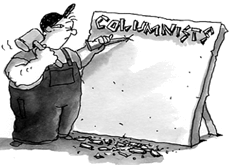Holding onto Hope: Gina Rinehart's Bleak House
 Tuesday, April 22, 2025
Tuesday, April 22, 2025 Seeking chunks of the huge iron ore pit, Hope Downs ... Tracing the tangled Wright, Hancock, Rinehart litigation ... Allegations of fraud against the family trust ...Manoeuvring ... Tax "advice" ... Shifting vesting date ... Money, the root of unhappiness ... Anthony-James Kanaan reports
 John Hancock and his mother Gina Rinehart in 2002
John Hancock and his mother Gina Rinehart in 2002
According to Leo Tolstoy, "All happy families are alike; every unhappy family is unhappy in its own way". And the Rinehart-Hancock family is uniquely unhappy.
Is there a collective noun for dozens of barristers? It's a question that asks itself as we try to untangle the sprawling litigation gravitating around Gina Rinehart, her family trust, Hancock Prospecting, and the Hope Downs Mining project.
Legions of lawyers have been pressed into duty on behalf of the belligerents.
On foot in the WA Supreme Court is the most apocalyptical case of them all: a dispute brought by the descendants of the late Peter Wright, business partner of the late Lang Hancock, who claim that they are owed both royalties and equity in the Hope Downs mines in WA's Pilbara.
The outcome of the dispute, which is worth billions of dollars, will have significant ramifications for Mrs Rinehart's control over her Hancock autocracy.
At the same time, two of her children - Bianca Rinehart and John Hancock - also claim a share in Hope Downs, and are enmeshed in a decades old struggle against their mother - claiming that she perpetrated a fraud against the family trust.
It's been difficult to keep track of these interconnected claims - but we'll do our best to chart their history.
It's a story of dynasties entwined by history and grudges, with the deepest of pockets to keep feeding their lawyers and their anger.
It's a reminder, as if we need one, that too much money can ruin a family.
Hanwright and the Hope Downs project
Lang Hancock was in his early forties when in the mid-twentieth century he was said to have discovered the world's largest iron ore deposits in the Pilbara region.
 Peter Wright and Lang Hancock in 1967
Peter Wright and Lang Hancock in 1967
At the time, he called upon his schoolmate and business partner Peter Wright to develop the deposits which he named Hope Downs after his then-wife, Hope Margaret Hancock.
Hope Downs consists of at least four mine sites and numerous tenaments. They were the subject of a partnership between Hancock and Wright, known as "Hanwright".
In 1984, after the success of their partnership, the pair decided to untangle their affairs by dividing their assets in an unsuccessful attempt to prevent future property disputes between their successors.
While Peter Wright passed away the following year, Hancock finalised the division of the partnership assets with two of Wright's children, Angela Bennett and Michael Wright, in 1987.
At present, the Hope Downs mines are jointly owned by Rio Tinto and Hancock Prospecting Pty Ltd, generating billions of dollars in revenue for both companies.
The Hope Margaret Hancock Trust
A year after the Hanwright assets were divided, Lang Hancock established the Hope Margaret Hancock Trust. The trust property includes 23.4% ownership in the Hancock Prospecting company – a share which is currently estimated to be worth upwards of $5 billion dollars.
The trust was created for the "education, advancement and benefit" of Gina Rinehart's four children - John, Bianca, Ginia and Hope. The remaining ownership in Hancock Prospecting belongs to Mrs Rinehart.
Mrs Rinehart became trustee after the death of her father in 1992. The property of the trust was meant to vest when Rinehart's youngest child, Ginia, attained 25 years of age – which ought to have occurred in September 2011.
Three days before the trust property was set to vest, Rinehart sent a letter to each of her children, claiming that the tax advisors to the trust, PricewaterhouseCoopers, advised that each beneficiary would become immediately bankrupt upon receiving their share in Hancock Prospecting under the trust.
This was because of the capital gains tax implications of their receipt of the assets, and because rules concerning the Hancock Prospecting shareholding made it near impossible for the shares to be sold to non-family members.
It was later revealed that Rinehart procured amended advice from PwC which overstated the effects of the vesting date.
One day later, Rinehart executed a deed of amendment to extend the vesting date of the trust to 2068. Her children then sued to remove her as trustee.
The Trust disputes
 Bianca Rinehart: appointed the replacement trustee
Bianca Rinehart: appointed the replacement trustee
By the time Justice Paul Brereton handed down judgment in the trustee replacement dispute which took place in the NSW Supreme Court in 2015, only John Hancock and Bianca Rinehart remained as plaintiffs - represented by Christopher Withers SC and instructed by YPOL Lawyers.
Rinehart's other two children, Hope and Ginia, dropped out of the proceedings in support of their mother - and, in Hope's case, in return for an advance of $45 million.
Justice Brereton found that Rinehart, who was represented by Noel Hutley SC and Corrs Chambers Westgarth, had gone to "extraordinary lengths" and had exerted "enormous pressure and great influence" to retain control of the trust.
HH did not find that she had acted with gross misconduct or in breach of trust. Before judgment was handed down, Rinehart voluntarily retired as the trustee.
Brereton did, however, find that Rinehart manipulated PwC into providing advice which she used to misrepresent the implications of the trust vesting to her children.
The court appointed Bianca as the replacement trustee, despite calls by her mother and Hancock Prospecting to appoint a professional trustee instead.
The court noted that it was reasonable to infer that Gina would try to exert influence over any person appointed trustee, and that Bianca was least likely to succumb to influence or pressure from Rinehart or Hancock Prospecting.
The appointment of Bianca to the trusteeship has also generated a significant amount of litigation. In the NSW CA Bianca successfully obtained the transfer of documents that her mother had failed to relinquish, but which Gleeson, Leeming and White JJA ruled were trust documents and belonged to her as trustee.
More recently in 2024, the WA Supreme Court threw out an application by Bianca and John to obtain a further set of documents from their mother, believing that they would enhance their claims over the Hope Downs mines.
Justice Natalie Whitby found that these documents were legally privileged and that the pair had "insufficient evidence" to support their claim.
Bianca and John are currently in arbitration against their mother, claiming that Rinehart committed fraud and breaches of her trustee duties by transferring mining assets out of the trust. This transfer included Hope Downs assets.
They sought to invalidate two clauses in deeds signed in 2006 and 2007 requiring that their dispute be subject to private arbitration. Ward CJ in Eq along with the Court of Appeal found that they were valid and binding clauses, and remitted the dispute to arbitration.
The pair also brought an unsuccessful challenge to the arbitration by claiming that the arbitrator appointed to dispute was not impartial or independent.
The Hanwright unwinding
 Gina Rinehart claims Rose pressured Lang to to place Hope Downs assets in the trust
Gina Rinehart claims Rose pressured Lang to to place Hope Downs assets in the trust
Back to WA, where the dispute brought by Wright Prospecting and Angela Bennett, daughter of Peter Wright, against Gina Rinehart and Hancock Prospecting is ongoing.
The claim was first brought in 2013, with its first decade of life predominantly defined by interlocutory applications and cross-claims. It is estimated that over 7,000 documents are associated with the case.
The plaintiffs (represented by John Rowland KC, Julie Taylor SC, and Eric Heenan SC, instructed by Clayton Utz) assert that their rights to royalties to part of the Hope Downs tenements that were not divested by Peter Wright in 1987.
They claim a share of royalties from several Hope Downs tenements, and an equitable interest part of Hope Downs which they believe are still subject to a partnership interest.
One of their primary items of evidence is a letter from Lang Hancock to his daughter in which he refers to the tenements as property held jointly with the Wrights.
Bianca and John also feature in this dispute, represented again by Christopher Withers SC and YPOL Lawyers, claiming that they are owed a share in the Hope Downs project because Lang Hancock originally placed a share of Hope Downs in the Hope Margaret Hancock Trust.
They assert that any rights they have to the Hope Downs would take priority over the interests asserted by the Wrights.
Ultimately they claim that Mrs Rinehart committed a fraud on the trust by taking those assets out of the trust and disposing of them to Hancock Prospecting.
However, Mrs Rinehart asserts that the Hope Down assets were placed in the trust by Hancock in breach of his fiduciary duties to Hancock Prospecting, under pressure from his then-wife Rose Porteous.
Rinehart tried deporting Porteous during the peak of their bitter feud, with Rinehart claiming that Rose was responsible for hastening the death of her father.
Hancock Prospecting, represented by Noel Hutley SC, Christian Bova SC, Peter Brereton SC (now Justice Brereton of the NSW Supremes), Charles Colquhoun SC and James Hutton SC, instructed by Corrs Chambers Westgarth, failed in an attempt to postpone the trial until after the outcome of the trust arbitration between Rinehart and Bianca and John.
 Don Rhodes: a key figure alongside Hancock and WrightThe dispute is also flanked by DFD Rhodes, a company related to Don Rhodes who was an associate of Wright and Hancock during the early years of Hope Downs.
Don Rhodes: a key figure alongside Hancock and WrightThe dispute is also flanked by DFD Rhodes, a company related to Don Rhodes who was an associate of Wright and Hancock during the early years of Hope Downs.
Represented by Jeremy Stoljar SC and Kim Lendich SC, instructed by Taylor & Taylor, the company and the family of Rhodes claim they are entitled to a royalty from the fruits of Hope Downs, on the basis of an agreement reached between the three businessmen in 1969.
In total, just under 30 barristers have been briefed by the various parties in the dispute. Maybe they could borrow the collective noun for crows - and be distinguished as a "murder of barristers".
John Hancock lives in London, to "insulate his family from the personal toll the case has taken on him since he first started asking questions about a family trust in 2004".
The decision of Justice Jennifer Smith of the WA Supreme Court on the claims brought by Peter Wright's children will either cement or erode the power and control that Mrs Rinehart has spent decades securing over her father's legacy – even at the expense of the disaffection of her own children.










Reader Comments